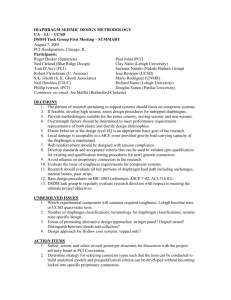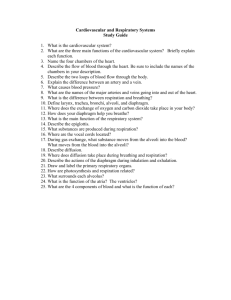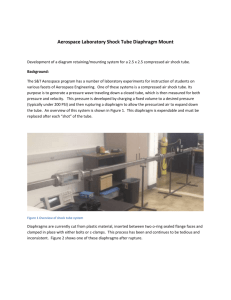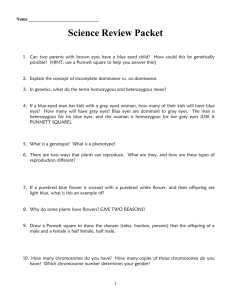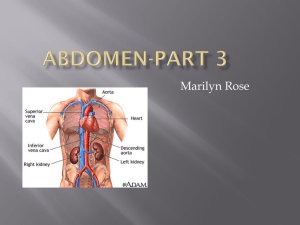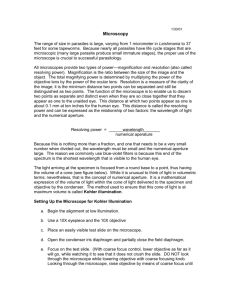AC14-0611-R1 #4 - ICC-ES
advertisement
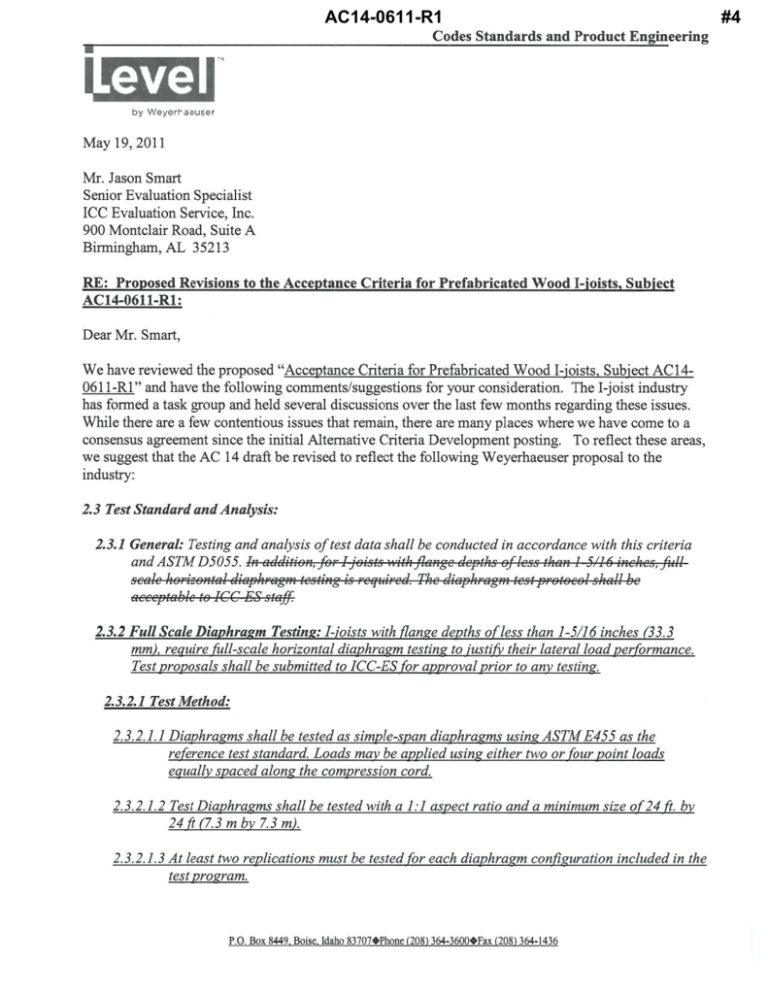
AC14-0611-R1 #4 I-Joist Diaphragm Systems: Performance Trends Observed with Full-Scale Testing Ned Waltz, P.E., S.E.C.B., and Dr. J. Daniel Dolan, P.E. Abstract Pre-fabricated wood I-joists are routinely used to construct roof and floor systems in modern lightframe wood construction. One of the primary functions of a light-frame floor or roof is to serve as a diaphragm that collects in-plane lateral load and transfers it to the shear walls and foundation elements. Since the existing diaphragm design provisions contained within the model building codes are based on a combination of testing and analysis conducted with sawn lumber framing, designers often question whether they can be reasonably applied to diaphragms framed with I-joists. This article summarizes some of the rationalization and limitations associated with I-joist framing for diaphragm construction. Performance trends and observations are presented based on one manufacturer’s experience with 41 fullscale I-joist diaphragm tests conducted in accordance with ASTM E455 (ASTM 2004). Introduction Modern light-frame roof and floor systems routinely combine pre-fabricated wood I-joists with wood structural panel sheathing. A primary function of a light-frame floor or roof is to serve as a diaphragm that collects lateral load and transfers it to the shear walls and foundation. Diaphragm design provisions for light-frame wood construction have been successfully employed for decades and were originally developed for lumber framing. Designers often wonder if they are equally applicable to diaphragms framed with wood I-joists. The objective of this article is to provide some insight into how shear capacities are rationalized for I-joist diaphragms and to summarize potentially useful trends observed with full-scale testing. Diaphragm Design Diaphragms are typically modeled as deep, inplane beams. Perimeter framing is designed to act as Summer 2010 tension/compression chords or struts. Wood structural panel sheathing combines with joists to serve as the “web” that transfers shear. Joists provide out-ofplane stiffening and load transfer between discrete panel sheathing elements. This makes sheathing-toframing attachment a critical element that often defines shear capacity of the assembly. Wood structural panel diaphragms are normally designed in accordance with provisions of the International Building Code (IBC) (International Code Council 2009) and the Special Design Provisions for Wind and Seismic (SPDWS) (American Wood Council 2008). Tables, like 2009 IBC Table 2306.2.1(1), were first developed in the 1950s and have evolved over time (Countryman 1952 and 1955, Peterson 1983, Tissell 1967, Tissell and Elliott 2004). The original rationalizations for these tables were based on an analysis of sheathing and attachment schedules for lumber-framed diaphragms with plywood panel sheathing. They have been subsequently modified based on results from a variety of full-scale test programs that introduced additional materials, failure modes, and design considerations. Original I-joist framing products used laminated veneer lumber (LVL) or sawn lumber flanges with thicknesses of 1.5 in. or greater. These thicknesses were consistent with 2 in. nominal material typically used to “block” a lumber diaphragm and exceeded specified minimum fastener penetration requirements. Provided that the diaphragm configuration adhered to the manufacturer’s fastener spacing recommendations to avoid splitting and the flange material could rationalize equivalent fastener performance to an appropriate sawn lumber species, it was judged that application of shear design tables like 2009 IBC Table 2306.2.1(1) could be extended to these products. As I-joist products are optimized, it has become common to see LVL flange thicknesses less than 1.5 in. The industry has long recognized that reducing flange thickness beyond a certain threshold has the potential to adversely impact sheathing nail embed9 Table 1. Peak strength comparisons between similar full-scale diaphragm tests1, 2 3,4 Notes for Table 1: All of the tests summarized in this table used I-joist framing with laminated veneer lumber (LVL) flanges. The “DF” and “SP” species designations represent Douglas-Fir and southern pine, respectively. 2 All of the tests summarized in this table used either plywood or oriented strand board (OSB) sheathing materials. 3 Except as noted in Lines 14 and 15, all of these full-scale diaphragms had dimensions of 24 ft. x 24 ft. 4 The majority of the comparisons are based on the average of two tests. However, only a single diaphragm was tested in the following cases: Line 3 Variables 1 and 2, Line 14 Variable 2, and Line 17 Variable 1. 5 Sheathing nails sizes were as follows: 6d - 0.113 x 2.0 in., 8d - 0.131 x 2.5 in., 10d - 0.148 x 3.0 in. 1 ment and split resistance to the point where diaphragm capacity may be influenced. International Code Council Evaluation Service (ICC-ES) acceptance criterion for I-joists defines that threshold as 1-5/16 in. (ICC-ES 2010) based primarily on sheathing nail embedment calculations (APA 2007). I-joist products with flanges thinner than 1-5/16 in. are subsequently required to conduct “full-scale horizontal diaphragm testing” to rationalize performance. At present, at least two manufacturers have conducted full-scale diaphragm testing to investigate performance of I-joist product lines with flange thicknesses less than 1-5/16 in. Both manufacturers have developed related design recommendations and limitations that are included in their evaluation reports. In general, the manufacturers have proven equivalence to a subset of the current diaphragm design tables for sawn lumber. They generally do not permit 10 thinner flanged I-joist products to be used in the highest load applications that require the closest sheathing attachment schedules. Full-Scale Testing At present, Weyerhaeuser has conducted 41 fullscale tests on I-joist diaphragm systems framed with I-joists with LVL flange thicknesses between 1-1/8 and 1-1/4 in. Figures 1 and 2 illustrate test conditions chosen to be consistent with requirements of ASTM E455 (ASTM 2004) and benchmark testing conducted with sawn lumber (Countryman 1955). A variety of I-joist materials, sheathing products, diaphragm configurations, sheathing fasteners, and fastening schedules have been tested to verify shear transfer and deformation performance capabilities. Given the high cost and relatively low variability of WOOD DESIGN FOCUS Figure 1. Typical diaphragm test configuration (24 x 24 ft., Case 5 shown). full-scale assembly testing, two replicates have typically been tested for each condition per the requirements of ASTM E455. Nearly all I-joist diaphragms have been tested with dimensions of 24 ft. by 24 ft. to focus on shear transfer capabilities and to correspond with a benchmark sawn lumber diaphragm test database. Regardless of configuration, observed diaphragm behaviors are fundamentally consistent. Initially, diaphragms deform elastically as a deep beam without perceptible relative movement between framing and sheathing. At loads in excess of design loads, visible Summer 2010 relative movement can be observed between adjacent sheathing panels and between panels and framing. Figure 3 illustrates these trends for a 2009 IBC Table 2306.2.1(1) “Case 5” diaphragm configuration that aligns panel joints in both directions. Shear flow causes panels at the reactions to rotate in opposite directions towards the span centerline. The magnitude of this rotation is typically consistent between diaphragm tension and compression chords. Due to panel geometry, the observed movement between adjacent sheathing panels is typically several times greater along long edge joints than at short 11 Figure 2. Illustration of test setup (24 x 24 ft., Case 5 shown). end joints. The large relative movement between panel edges creates a tension perpendicular-to-grain splitting force across the framing at the fasteners for adjacent panels. At panel end joints, it induces perpendicular-to-grain forces into the framing as panel end joints rotate and the nails induce perpendicularto-grain prying forces into the framing. Ultimately, these deformations lead to failure in some combination of panel buckling/crushing, sheathing nail withdrawal, framing splitting, and/or sheathing edge tear out. The Case 1 diaphragms tested exhibited similar behavior with the exception that panel bearing and crushing were also observed between interlocking panel rows. Figure 4 illustrates the mode of failure observed for a “blocked” Case 1 diaphragm. However, as with the benchmark sawn lumber tests, the dominant failure modes observed with I-joist diaphragms were tension perpendicular-to-grain fracture of the framing and sheathing nail withdrawal. Sheathing related failure modes played a less significant role. Given that many of the potential diaphragm failure modes that limit capacity are not typically addressed by a connection analysis, the importance of test-based verification for diaphragm systems that depart significantly from the historical basis seems to be confirmed. Performance Trends The compiled database of full-scale I-joist diaphragm tests provides an opportunity to draw com12 parisons between similar test sets. While extrapolations beyond tested conditions should be approached with caution, comparisons in Table 1 suggest trends that could be useful to the designer: Flange Species: Douglas-fir LVL flanged I-joists outperformed their southern pine counterparts in 4 out of the 5 similar diaphragm configurations tested (Lines 1-5). This trend contradicts what is expected based on a sheathing fastener connection analysis that assumes a higher specific gravity for southern pine. This trend may be due to the difference in tension perpendicular-to-grain strengths or typical veneer thicknesses of the LVL fabricated with each species. How well these particular commercial species combinations fit the specific gravity-based fastener design models may also play a role. Regardless, it highlights that an I-joist manufacturer needs to evaluate the diaphragm performance of each primary species used for flange material. It also suggests that designers should avoid applying the diaphragm recommendations for one I-joist product to another. LVL Veneer Thickness: The Line 6 comparison illustrates what a relatively subtle difference in I-joist product composition can have on capacity. Diaphragms framed with LVL flanges that had the same species and grade but used a slightly thicker veneer peel had about 15% less capacity. As with the last item, this would seem to confirm that diaphragm performance is product dependent. It further emphasizes that extrapolation of performance recommendations WOOD DESIGN FOCUS Figure 3. Typical diaphragm movement mechanisms (Case 5 shown). between seemingly similar manufacturers and products should be avoided. Blocking Quality: Line 7 illustrates the influence that blocking selection can have on capacity. Even with I-joist materials taken as being a constant between tests, use of low specific gravity blocking material (0.45 vs. the intended 0.50) reduced diaphragm capacity by about 15%. This shows that selection of a blocking material is likely as important as selection of a joist and should be consistent with the design assumption. For example, avoid using spruce-pine-fir blocking if Douglas-fir diaphragm design values are targeted. Flange Width: Comparisons on Lines 8-11 illustrate that, as with sawn lumber, wider framing results in increased capacity. This is consistent with the code design provisions and can be attributed to the fact that wider framing tends to reduce splitting and can provide for increased edge distance and staggered nail patterns that provide better load transfer. Nail Size: Line 12 illustrates that a relatively intense 10d sheathing nail pattern resulted in a 16% increase in capacity relative to using 6d sheathing nails. In contrast, corresponding shear design capacities for lumber diaphragms increase by about 70%. This highlights the importance of flange splitting and the need for the manufacturer to address the resulting capacity limitations in their design guidance. Also, since the design recommendations provided by Summer 2010 the manufacturer are typically governed by “worst case” conditions that involve larger diameter fasteners, there is likely some relative conservatism associated with smaller diameter fasteners. As with most wood connections, it is another example where more/larger fasteners do not necessarily improve performance if they lead to splitting. Diaphragm Case: The design codes permit six different diaphragm configurations to be constructed. It is not intuitively obvious that they are all equal when it comes to I-joist diaphragm performance. The majority of tests summarized by Table 1 were undertaken using the “Case 5” configuration illustrated by Figures 1-3 that aligns panel joints in both directions. Since splitting was a primary concern, this was judged conservative because it maximized the number of fasteners and requires the full lateral load to be transferred through the I-joist flanges. The Line 13 comparison confirms that assumption relative to the “Case 1” configuration that requires fewer fasteners and interlocks the panels. It also suggests that there are some relative benefits for the designer to, whenever possible, favor specification of diaphragm “cases” that use interlocking panels and fewer fasteners to transfer shear. Diaphragm Size: The 24 ft. by 24 ft. diaphragm size used for most of the testing summarized by Table 1 was chosen to promote shear distortion in a condition that combined full-size sheathing elements 13 with at least 2 interior panel joints in each direction. It also corresponded with a benchmark database for sawn lumber (Countryman, 1955). As suggested by Lines 14 and 15, testing other sizes may result in slightly different answers. This highlights the importance for the manufacturer to evaluate a configuration that encourages realistic stress flows through the system if design values are being developed. The designer should also specify products that have been rationalized accordingly. Fastener Type: Lines 16 and 17 provide some insight into the relative influence of fastener selection. Eight penny (8d) ring shank (0.120 in. diameter) and 8d common (0.131 in. diameter) nails are assumed to provide equivalent performance for unblocked diaphragms in some prescriptive situations. The fullscale tests of Line 16 suggest that the smaller diameter ring shank nail actually out-performed the larger diameter common nail. Line 17 provides a similar comparison for a proprietary fastener that claims superior diaphragm performance for some configurations based on small-scale fastener testing and analysis. In reality, the proprietary fastener performed about the same as the smaller diameter ring shank nail. Extra withdrawal and lateral resistance doesn’t necessarily translate into improved diaphragm performance if an alternative failure mode not addressed by the fastener review, such as framing splitting, governs. The designer should be cautious when specifying proprietary fasteners that claim diaphragm performance improvements that have not been verified against all failure modes possible in a full-scale diaphragm. Stiffness Observations In some cases, a designer will also need to predict diaphragm deformation. For sawn lumber diaphragms, this is typically done using either the traditional “4-term” or simplified “3-term” diaphragm deflection equations (American Wood Council, 2008). Calculation procedures developed for sawn lumber diaphragms also provide a reasonable means of predicting I-joist diaphragm deformation in the design range. Figure 5 illustrates a comparison between calculation methodologies and the measured behavior for a Case 5 I-joist diaphragm configuration that conservatively combined large diameter fasteners with a tight spacing that tends to promote splitting. For this example, observed performance reasonably approximated modeled deformation predictions based on the tested Case 5 configuration. It should be noted that the actual deformations are less than deformations predicted using the default apparent shear stiffness term in SDPWS. The SDPWS default is conservatively based on Case 1-4 diaphragm configu14 Figure 4. Failure modes — framing splitting from panel prying (Case 1 shown). rations which have fewer nails (e.g. greater load per nail) at panel edges than the Case 5 diaphragm configuration tested. One of the benefits of testing diaphragms with a 1:1 aspect ratio is that it focuses the test on the shear strength and deformation of the assembly. A downside is that deflection measurements are small. For example, at a load and resistance factor load for the configuration illustrated, the disparity between the measured deformation and the Case 5 predictions was about 1/16 in. This absolute differential arguably falls below the reasonable precision of the full scale test method and highlights that the absolute magnitudes of deformation should be considered when interpreting the accuracy of a predictive model. Conclusions Subject to the manufacturer’s recommendations, pre-fabricated wood I-joists can be used for diaphragm construction. However, the performance of an I-joist diaphragm assembly will be dependent on the specific I-joist product used and its relevant attributes (i.e. flange geometry, material, species, veWOOD DESIGN FOCUS Figure 5. Deflection predictions. neer thickness for LVL flanges, etc.). Few I-joists can serve as a direct substitute for sawn-lumber framing in the full range of applications addressed by building code diaphragm design provisions. The manufacturer’s sheathing nail spacing and diaphragm design recommendations should always be considered as part of the design process. References APA-The Engineered Wood Association. 2007. TT061A: 1-5/16 in. Thick I-Joist Flanges and Diaphragm Nail Penetration. Tacoma, WA. American Society for Testing and Materials. 2004. E455: Standard Test Method for Static Load Testing of Framed Floor or Roof Diaphragm Constructions for Buildings. West Conshohocken, PA. American Wood Council. 2005. National Design Specification for Wood Construction. Washington, DC. American Wood Council. 2008. Special Design Provisions for Wind and Seismic. Washington, DC. Countryman, David. 1952. Laboratory Report 55: Lateral Tests on Plywood Sheathed Diaphragms. Douglas Fir Plywood Association. Tacoma, WA. Countryman, David. 1955. Laboratory Report 63a: 1954 Horizontal Plywood Diaphragm Tests. Douglas Fir Plywood Association. Tacoma, WA. Summer 2010 International Code Council. 2009. International Building Code. International Code Council. Country Club Hills, IL. International Code Council Evaluation Service. 2010. AC14: Acceptance Criteria for Pre-Fabricated Wood I-Joists. Whittier, CA. Peterson, J. 1983. Bibliography on Lumber and Wood Panel Diaphragms. Journal of Structural Engineering. 109(12):2838-2852. Tissell, J.R. and Elliott, J.R. 2004. Report 138: Plywood Diaphragms. APA-The Engineered Wood Association. Tacoma, WA. Tissell, J.R. 1967. Laboratory Report 106: 1966 Horizontal Plywood Diaphragm Tests. American Plywood Association. Tacoma, WA. Ned Waltz, PE, SECB, Senior Engineer, Product Evaluation, Weyerhaeuser Company, Boise, ID. Contact him at ned.waltz@weyerhaeuser.com. J. Daniel Dolan, P.E., Professor and Director of Codes and Standards, Composite Materials and Engineering Center, Washington State University, Pullman, WA. Contact him at jddolan@wsu.edu. 15 AC14-0611-R1 #4 May 20, 2011 Mr. Jason V. Smart Senior Evaluation Specialist ICC Evaluation Service, Inc. 900 Montclair Road, Suite A Birmingham, AL 35213 Re: Proposed Revisions to the Acceptance Criteria for Prefabricated Wood I-joists, Subject AC140611-R1 (JS/KS) Dear Mr. Smart: We have reviewed the proposed revisions to AC14 and would like the committee to consider the following comments and suggested modifications. 1) Remove portions of 2.3.2 and relocate to 2.3.2.2 (new) and 2.3.2.3 (new). 2.3.2 Full Scale Diaphragm Testing: I-joists with flange depths of less than 1-5/16 inches (33.3 mm)require full-scale horizontal diaphragm testing to justify their lateral load performance. Test proposals shall be submitted to ICC ES for approval in advance. Any proposed diaphragm test program shall conservatively bracket the range of permitted applications in terms of flange material, flange dimensions, allowable lateral load, joist spacing, sheathing thickness, nail diameter/type, nail spacing, blocking inclusion, and diagram “case” configuration as described by 2006 IBC Table 2306.3.1. The full-scale diaphragm test program shall include the following minimum elements: 2) Add 2.3.2.1 and group together requirements that are specific to the test method. 2.3.2.1 Test Method: 2.3.2.1.1 Diaphragms shall be tested as a simple-span diaphragms using ASTM E455 as the reference test standard. Loads may be applied using either two- or four -point loads equally spaced along the compression chord. 2.3.2.21.2 Test diaphragms shall have a1:1 aspect ratio and a minimum size of 24 feet by 24 feet (7.3 m by 7.3 m). 2.3.2.5 1.3 At least two replications shall be tested for each diaphragm configuration included in the test program. 2.3.2.6 1.4 The permitted allowable shear (pounds per foot) seismic design load derived from the test shall be the average maximum reaction achieved in all diaphragm tests of the same configuration, divided by the diaphragm depth in feet, divided by a factor of 2.8. Page 2 May 20, 2011 3) Add 2.3.2.2 and group together requirements that are specific to specimen design. Revise, expand, and clarify 2.3.2.7 with 2.3.2.2.3 (new), 2.3.2.2.4 (new), and 2.3.2.2.5 (new). Reason: Manufacturers may be compelled to evaluate a proprietary joist, fastener, or sheathing material in the Case 1 configuration in order to evaluate the failure mechanism of their product in its primary end-use condition. However, limited research has shown that in blocked diaphragms a Case 5 configuration may be a slightly (7% difference) more conservative configuration to test for qualification purposes. While this difference is within the margin of error for diaphragm testing the suggested revisions below recognize that Case 5 may be the conservative configuration for blocked diaphragms. 2.3.2.2 Specimen Design: 2.3.2.3 2.1 I-joist materials shall be used for the floor joistsframing members and parallel closure at the diaphragm edges. Blocking used in the field of the diaphragm and rim board material used for perpendicular closure shall be consistent with that permitted in the application. 2.3.2.4 2.2 The I-joist framing materials members may be reinforced as necessary to get the concentrated test loads into and out of the test diaphragm. However, the framing reinforcement must be consistent for all tests, and shall not contribute favorably to the sheathing-to-flange connection, and shall notor increase the shear strength or stiffness of the constructed diaphragm by 2% or more. This shall be confirmed by running at least one unsheathed diaphragm test as outlined in Section 9.1 of ASTM E455. The unsheathed diaphragm configuration used for the confirmation test shall be compared against the sheathed diaphragm with the lowest capacity in the test program. 2.3.2.2.3 Equivalence for all unblocked diaphragm configurations may be established by testing the unblocked Case 1 configuration with the highest desirable allowable shear for the targeted nominal width of framing, as described by Table 2306.2.1(1) of the 2009 IBC or Table 2306.3.1 of the 2006 IBC. 2.3.2.2.4 Equivalence for Cases 1 through 4 blocked diaphragm configurations may be established by testing the blocked Case 1 configuration with the highest desirable allowable shear for the targeted nominal width of framing, as described by Table 2306.2.1(1) of the 2009 IBC or Table 2306.3.1 of the 2006 IBC. 2.3.2.2.5 Equivalence for all blocked diaphragm configurations may be established by testing the blocked Case 5 configuration with the highest desirable allowable shear for the targeted nominal width of framing, as described by Table 2306.2.1(1) of the 2009 IBC or Table 2306.3.1 of the 2006 IBC. 2.3.2.7 Diaphragm approvals shall be limited to the 2006 IBC Table 2306.3.1 “case” configuration tested. Exception: Any 2006 IBC Table 2306.3.1 “case” configurations shall be permitted in application when a Case 5 diaphragm configuration is used for testing. Page 3 May 20, 2011 4) Add 2.3.2.3 and group together requirements that are specific to member design. Revise and clarify 2.3.2.8 with 2.3.2.3.1 (new) and 2.3.2.3.2 (new). Reason: Structural Composite Lumber (SCL) flange material is evaluated in accordance with ASTM D5456 and AC47. Within these documents the variables to be considered for qualification and ongoing quality control testing is clearly defined. Specifically, the evaluation of connection performance is outlined in section 3.2 of AC47 which states, “Connection tests, in addition to those required in Sections 3.2.1 and 3.2.2 of this criteria, must be conducted on each product having different wood species. In addition, each grade shall be tested unless recognition of fasteners is based on the tests of the lowest grade.” In addition, X1.3.9 of ASTM D5456 requires the evaluation of material splitting when combinations of fastener size, spacing, and penetration are aligned in a row. The suggested revisions below recognize the critical variables that are specific to a full-scale diaphragm test and complement existing evaluation procedures. 2.3.2.3 I-Joist Member Design: 2.3.2.3.1 The I-joist member with the minimum desired flange depth and that product’s minimum width shall be used to establish equivalency. 2.3.2.3.2 The I-joist member with the minimum desired grade and/or equivalent specific gravity for connector design, as defined in section 3.2 of AC47 for both nail withdrawal and dowel bearing in the Y-L and Y-X directions, shall be used to establish equivalency. 2.3.2.8 The applicant shall prove, by limited full scale diaphragm testing, that the i-joist flange material used for the test program conservatively represents the range of materials that will share the same design value for a given diaphragm configuration in application. The governing joist material shall be selected for the test program. This comparison shall be made by testing single replications of the diaphragm configuration with the highest corresponding design load. Variables to be considered in this screening include, but are not limited to: flange thickness, wood species used for the flange material, flange density, flange stiffness, flange width, veneer peel thickness for I-joists that use laminated veneer lumber flanges. Page 4 May 20, 2011 Thank you for this opportunity to comment on the proposed revision. Sincerely, Guy T. Anderson, P.E. Engineering Manager, Codes and Standards Boise Cascade Engineered Wood Products LLC Joe Kaiserlik, P.E. Product Development Manager Georgia-Pacific Wood Products LLC Borjen (“B.J.”) Yeh, Ph.D., P.E. Director Technical Services Division APA – The Engineered Wood Association Phil Vacca, PE EWP Sr. Engineer Louisiana-Pacific Corp. Dave Anderson, P.E. EWP Senior Engineer Roseburg Forest Products AC14-6011-R1 #4 May 20th, 2011 Jason V. Smart Senior Evaluation Specialist ICC Evaluation Service, LLC 900 Montclair Road, Suite A Birmingham, AL 35213 Subject: ICC­ES AC14­0611­R1 Dear Mr. Smart, We have reviewed the proposed revisions to AC 14. As the proposed revisions provide a standard set of provisions for diaphragm testing, Simpson Strong­Tie would like the ICC committee to consider the following comments. Section 2.3.2.7: The proposal, as written, requires the testing of each case configuration as tested unless a Case 5 configuration is tested. The Case 5 condition is not a common case condition that is seen in the field. Additionally, the panel configuration as it relates to the framing may cause a failure mode that is not as prominent as the other cases. Case 1 is a very common case used in the field. Therefore, consideration should be made to allow testing in the unblocked and unblocked Case 1 condition and allow the other appropriate cases be bracketed by that testing. Thank you for your consideration of these comments and revisions. Please email me at akhachadourian@strongtie.com or call me at (925) 560­9022 with any questions or comments you may have. Sincerely, Simpson Strong­Tie Co., Inc. [Electronic] Aram Khachadourian, P.E. R&D Engineer, SST 1 of 1 Simpson Strong-Tie Co., Inc. 5956 W. Las Positas Boulevard, Pleasanton, CA 94588 Phone: 925.560.9000 Fax: 925.847.1605 www.strongtie.com AC14-0611-R1 Stanley Fastening Systems Briggs Drive East Greenwich, RI 02818 Robert J. Leichti, Ph.D. Manager Product Compliance, Hand Tools & Fastening #4 T: 401-471-4166 F: 401-884-2485 E : Robert.Leichti@sbdinc.com May 16, 2011 Mr. Jason Smart ICC- Evaluation Service 900 Montclair Road, Suite A Birmingham, AL 35213 RE: AC14-0611-R1 Dear Mr. Smart; Staff has proposed revisions to the requirements for diaphragm testing of thin-flange wood Ijoists and the subject has been placed on the agenda for the upcoming Criteria Development Hearing. It seems that diaphragm testing requirements have become an issue in several ACs. Some clarifications are needed for test standards and analysis requirements in AC14, Section 2.3, and at the same time, some of the proposed revisions to AC14 are concerning in technical justification and cost-benefit outcomes. I had an opportunity to review the editorial revisions being proposed by the APA and their members. Their revisions to the AC14 organization should be implemented. The impact of the proposed revisions proposed in Section 2.3 related to size of test specimens and numbers of tests could be far reaching even though the technical basis lacks justification. My comments focus on three aspects of the proposed revisions: (1) diaphragm size and boundary conditions, (2) numbers of tests, and (3) other considerations. Issues related to test specimen size and boundary conditions The paper by Waltz and Dolan (2010) is the most recent publication on wood-frame diaphragms and is unique in that it reports information on wood I-joist diaphragms. Waltz and Dolan justify the 24x24-ft dimensions based on the benchmark testing by Countryman (1955), which used similar size, aspect ratio, and boundary conditions. However, the bibliography by Peterson (1983) complied for the ASCE Committee on Wood and published in the Proceedings of the Structural Division show that Countryman (1966) also conducted diaphragm test using other sizes and reported using aspect ratios that ranged from 1:1 to 3.5:1 (APA, TR138). In fact, a lot of the early diaphragm testing (1945-1975) was done on much larger dimensions (60 ft lengths in some cases) and nearly all were in aspect ratios other than 1:1 (1:1 to 5:1). In the 1970s, Johnson and others at Oregon State University specifically examined the effect of diaphragm scale. Their work may still be available through the College of Forestry Publications Office, but many of those test reports from the early 1970’s are out of print and not easily available. The work by Dolan and Waltz shows that the effect of size and aspect ratio seem immaterial to I-joist Mr. Jason Smart RE: AC14-0611-R1 Page 1 of 4 diaphragms when they compared the performance of 24x24-ft and 12x24-ft diaphragms loaded as simply supported beams and concluded that using a size other than 24x24-ft “may result in slightly different answers.” The test methods of ASTM E455 include both simply supported tests and cantilever tests. The test method used by AISI in S907-08 is a cantilever test (minimum dimensions are 12x12 ft where rectangular up to 1:1.33 is permitted). The proposed use of test method of ASTM E455 treats the diaphragm as a deep beam on simple supports. This analogy works well because we can manage engineering analysis using simple mechanics theory. A cantilever beam analogy also works well as a simple mechanics model. However, a diaphragm on a concrete foundation is not subject to those boundary conditions and even the boundary conditions of the framed second-floor diaphragm differs from the model in that the diaphragm is sitting on springs (the shear walls) rather than a pin and roller, and the end rotations are constrained by the supported walls. The actual deformation of a framed second-level diaphragm probably fits between the simply supported deformations and cantilever deformations because the bottom plate of an attached wall when fully fastened acts to stiffen the boundaries through partial composite action. The wall plates have a moment of inertia that is greater than a 2x12 rim board in the plane of bending and also act to constrain the rotation of boundary sheathing panels. No evidence is given by Waltz and Dolan or others that indicates the cantilever method or the simply supported beam method yields a preferable or objectionable outcome. Issues related to numbers of required tests ASTM E455 acknowledges that diaphragm tests are large and expensive and exhibit low variability. Waltz and Dolan noted these same features. For that reason ASTM E455 permits testing a single replication when multiple configurations are being evaluated. The object is to use dissimilar constructions as the basis for rational engineering assessment. Consider, for example, a situation where four diaphragm tests are conducted without replication: the analysis would examine whether the tests are consistently below the Code values, whether they are consistently above the Code values, or whether they are effectively equivalent to Code values. A test of one configuration needs some replication, but with multiple configurations used in comparison to code values, the different and non-replicated tests form a body of evidence that that when used in a pairwise comparison to the Code values is as effective from a statistical perspective as using means of two tests to make the same pairwise comparison. Ultimately, the analyst has to interpret limited pairwise comparisons with few degrees of freedom. Other considerations (1) The AC14 revisions are written in terms of “floor” diaphragms (Section 2.3.2.3). No mention is made of roof diaphragms and whether the testing for floor diaphragms is applicable to roofs (flat or pitched). A revision to the AC should specifically state that the results of diaphragm tests are applicable to floor and roof diaphragms. (2) One should search the literature and anecdotal reports of structural inspections in the aftermath of natural hazard events to find instances where floor and roof diaphragms have exhibited failures in building structures that resemble the failures that we are looking at in AC14; it is possible that no instances are reported. Even in the NDS seismic tests of the six-story Mr. Jason Smart RE: AC14-0611-R1 Page 2 of 4 wood-frame structure conducted in the summer of 2010, no diaphragm failures or distress was observed even though the building experienced a MCE. (3) For lack of time, my remarks have not addressed the issues surrounding laboratory expense, cost (and consumption) of materials, and time to conduct testing that is necessary to address the many variables that are raised in the Staff proposed revisions. In seismic/wind force resisting systems of wood-frame structures, most of the deformation occurs in the vertical systems, so a positive cost-benefit ratio for a test program with replicated tests using a 24x24 ft specimen is difficult to imagine. (4) A small-scale method of evaluating the relative diaphragm capacity as a function of construction materials and failure mechanics related to sheathing rotations and interference like that of a full-scale diaphragm is not difficult to imagine. It should be raised to the ASTM Committee on Wood where it logically would be investigated and developed. Synopsis -- What do we know about the fundamentals of testing wood-frame diaphragms? • Evidence by Waltz and Dolan (2010) indicate that full-scale assembly testing demonstrated “relatively low variability.” Low variability has been shown for shear walls and assemblies in general. • Evidence from the APA (TR138) indicates that sheathing strength is fully developed with 10d common nails and even 8d common nails (or equivalent for some sheathing products), and as a result, in assemblies where the sheathing strength is fully developed, failure is forced into the framing members. As a result, I-joist diaphragm performance is enhanced to a point by using more smaller, ductile fasteners than fewer bigger fasteners. • The effect of configuration is difficult parse out of the data because the data are sparse. Waltz and Dolan (2010) indicated that “behaviors are fundamentally consistent” for different diaphragm cases. The dominate failure modes for I-joists as reported by Waltz and Dolan paralleled those with sawn lumber as reported by Countryman – “tension perpendicular to the grain fracture of the framing and sheathing nail withdrawal.” These are the result of sheathing panel rotations in the plane of the diaphragm. No information has been presented showing that either the simple beam method or the cantilever test method produces “better results.” • The effect of diaphragm dimensions is not obvious. Waltz and Dolan (2010) conclude that “testing other sizes may result in slightly different answers.” If the work on diaphragm scale by Johnson et al from the 1970s can be found, it will provide more important information. However, in the absence of other information, it appears that test specimens with planer dimensions greater than12 x 12 ft are unnecessary. • Framing member dimensions affect diaphragm performance whether using sawn lumber or I-joists – width and depth of sawn framing and I-joist flanges affect diaphragm load capacity. In summary, the AC14 proposed revisions to required specimen dimensions and numbers of tests need further study and open discussion before the ES Committee can make a rational assessment. Mr. Jason Smart RE: AC14-0611-R1 Page 3 of 4 The indulgences of the Committee and the readers of this letter are genuinely appreciated as I commented on behalf of Stanley Fastening systems, LP and Stanley Black & Decker, Inc. Sincerely, STANLEY BLACK & DECKER [Electronic] Robert J. Leichti Manager Product Compliance, Hand Tools and Fastening Mr. Jason Smart RE: AC14-0611-R1 Page 4 of 4


